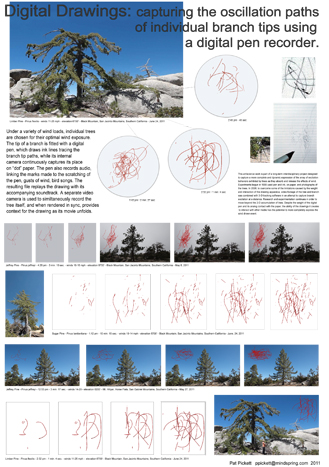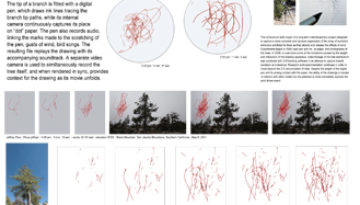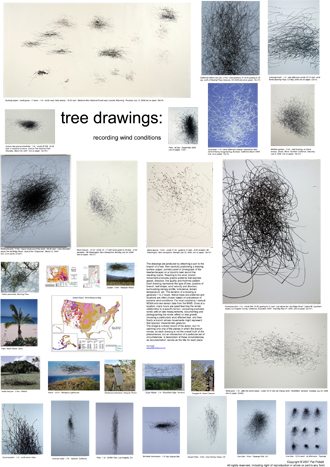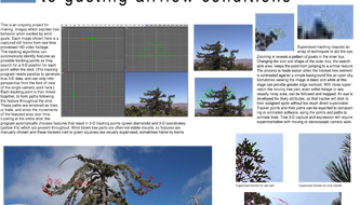Digital video tracking imagery of tree movement interactions with gusting airflow conditions
P. Pickett
ABSTRACT
In order to trace the movements of trees as they interact with gusting wind in a complex terrain, illustrations are produced using a 3-D tracking program. The animation of specific tree behavior will be based on digital information chosen from within field-gathered footage to show the paths of foliage, branch and tree movement. The biomechanical response of leaves, branches, limbs, canopy, and/or trunk displacement can be captured, and a story told of the effects of gusting wind conditions upon a single tree, and further, over the forest and/or across edge terrain. By choosing tracking points on trees from the entire framed landscape, the response of an individual tree in the foreground can be seen within the context of the surrounding canopy. The trailing imagery can illustrate specific wind loading strategies, and show range of movement from crown to lower branches. Wind speed data are recorded in the field during filming and are provided for each digitally animated, video-captured event. Gust excitation and sway response, as well as the characteristic movements of distinct elements (trees, forest canopy, shrubs, grasses), can be individually expressed in this process using the vocabulary of art.
1. Introduction
Art and science share the need to give visual expression to events, data, forces, ideas – things that might not otherwise be seen. Working between the disciplines, I am interested in the physicality and expressiveness of measurable circumstances, and in the accumulation, over time, of this visual information.
My interest in the effects of wind on trees began in 1999 as part of a series of works designed to expand the definition of drawing to include marks made in response to the stimulation of an external phenomenon. I looked beyond traditional artistic responses to light and its visual effects, to the environment for examples of forces that would only be made visible by their effects and corresponding response characteristics I imagined visual residues accumulating around the branches of trees swaying in the wind.
I began with “Tree Drawings”, in which I attached a pen to the end of a branch and positioned a drawing surface (paper, panel, photo of the tree) below in order to capture the track of the branch movement when excited by the wind. It was an experiment designed to begin to capture the movement of individual branches under a wide variety of wind conditions. Patterns emerged that were at once aesthetically pleasing and informative.
Building upon and proceeding from an analog representation of branch excitation, this digital video-tracking project is designed to more fully realize the original drawing experiments, and to create a more dynamic picture event of tree behavior.
2. Measurable circumstances – the process
What follows is a snapshot of the first steps taken in what will be a long-term motion-drawing project. Video footage is gathered while on drawing expeditions in the field, from a variety of wind conditions and terrains. This process does not require foreign tracking objects to be inserted into the tree. Relying solely on the video footage of the trees for tracking information will allow for the greatest flexibility in capturing the behavior of very tall trees, trees in difficult terrain, trees at a distance, or a larger view of the landscape.
Once in the studio, the footage is sorted and edited. Crucial to the process is finding digital tools that will provide dependable data for the array of compositing programs that will be utilized later in the process to create the most expressive and animated pictures of tree movement. Using a 3-D tracking system, the footage of trees in gusting conditions is analyzed for the best examples of clearly identifiable tracking points.
Set to run automatically, the tracking program chooses 2-D points to solve for motion and, if they exist, to solve for 3-D coordinates. Trails follow tracker coordinates and serve as a tracer-picture of the path of the branch tip, resulting ultimately in the ability to represent the wind-effect-on-trees-event over time. In supervised tracking, each feature is selected manually, monitored and corrected as needed to follow a selected set of pixels throughout the shot. A black and white version allows for easier supervised tracking, especially at lower resolutions.
3. Conclusion
Attempts to “picture” an event in nature, whether by drawing, painting, graphs, diagrams, statistical modeling, measured experiments, or photographic processes: all are but approximations and tell only part of the story. The results of this project promises to continue the conversation between a phenomenon, its recording, and an artists’ response. It will evolve within languages both aesthetic and useful






